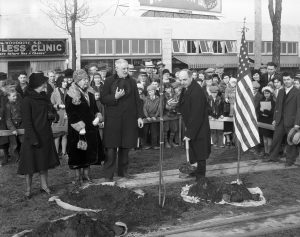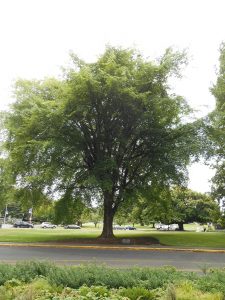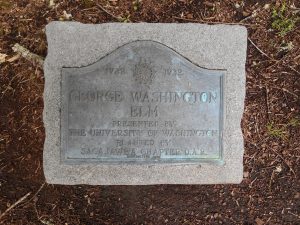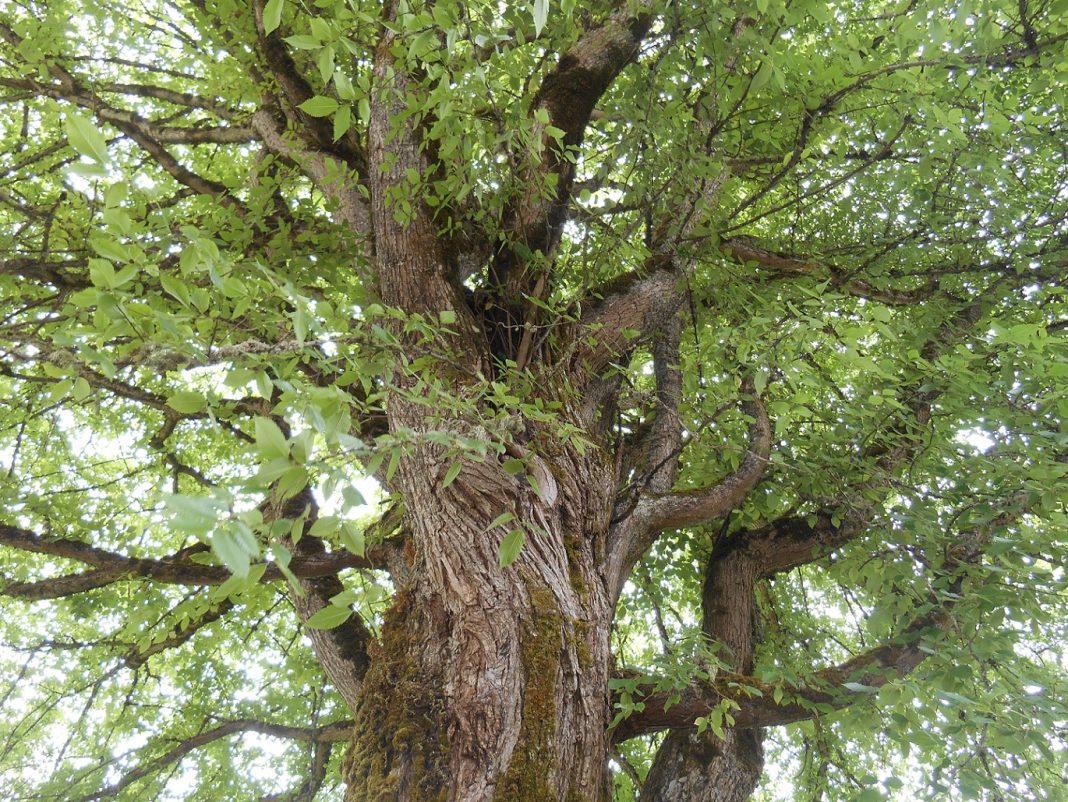Washington is the only American state named after a president. It is named for George Washington (1732-1799), the Revolutionary War leader who served as the first president of the United States. The Capitol campus in Olympia has a famous bust of the American  leader in the Legislative Building. A less noticed memorial to George Washington stands across from the Helen Sommers building near Capitol Way: an elm tree planted in 1932, on the bicentennial of the leader’s birth.
leader in the Legislative Building. A less noticed memorial to George Washington stands across from the Helen Sommers building near Capitol Way: an elm tree planted in 1932, on the bicentennial of the leader’s birth.
The elm is a descendant of a tree in Cambridge, Massachusetts. According to legend, George Washington stood under the original tree to take command of the Continental army on July 3, 1775. This American white elm (Ulmus Americana, native to the central and eastern half of North America) soon became a symbol of patriotism and George Washington.
Washington’s elm began to deteriorate by the end of the 19th century, due to old age and misguided attempts to help. Many people, however, were determined to keep the tree’s legacy physically alive. In 1896, John Collins, a University of Washington alumni doing graduate study work at Cambridge University, received permission to send cuttings of the tree to Professor Edmund Meany at his old school in Seattle. Meany was able to grow a sapling from a cutting, which was planted on the University of Washington campus.

In 1923, the original Cambridge tree died, accidentally pulled down by workers removing a dead branch. The whole nation mourned the loss. University of Washington gardeners were able to grow saplings from cuttings of their tree and sent them to capitals and college campuses around the country in the early 1930s, conveniently coinciding with increased interest in George Washington during the bicentennial of his 1732 birth.
People in Olympia were eager to get a tree of their own. A bicentennial committee, made up of local citizens and patriotic organizations, organized city-wide celebrations for George Washington. Through the Sacajawea Chapter of the Daughters of the America Revolution, they obtained a sapling. The committee was chaired by Judge Walter Beals of the Washington State Supreme Court.
Planting a sapling was a popular move. Editors of the Daily Olympian newspaper, writing on February 14, excitedly declared that the tree would make history and “with the planting Olympia will take a favored place among the cities of the nation, for only the national capital has a like tree” (besides Seattle at the time).

The committee originally planned to hold the planting on Washington’s actual birthday (February 22), but moved it to Thursday, February 18 when schools were in session and classes could come. The event consisted of a ceremonial planting and then a dedication program held at the Olympia High school auditorium. At the time, the school was nearby at 1125 Washington Street.
The tree was planted near the site of Territorial Governor Isaac Stevens’ home, which had been torn down a few years before. Stevens’ daughter Kate Stevens Bates attended the ceremony, along with other pioneers and school classes. They watched Sacajawea Chapter Regent Wava Bowman give a short speech about the history of the tree before presenting it to Governor Roland Harley, who formally accepted it on behalf of the state. Hartley put the first shovelful of dirt around the base of the elm and University of Washington gardener Ludwig Metzger finished the planting. To conclude the ceremony, Gertrude Vance, chaplain of the Sacajawea Chapter of the D.A.R., read what was believed to be George Washington’s favorite prayer.
After the planting, dedication festivities were held in the auditorium. Herbert T. Condon, dean of men at the University of Washington, gave a long speech about the importance of the original Washington elm. In the speech, preserved at the Washington State Library, Condon described the original “tree destined as it was to be revered in the hearts of its countrymen and to become the shrine of the millions.”

The dedication had vocal solos, a Boy Scout-led flag salute, and the American legion band played “Stars and Stripes Forever.” Judge Beals gave an impassioned “Tribute to Washington,” describing the first president as a paragon of unselfish patriotism. The D.A.R. awarded prizes to seventh and eighth grade students for essays about Washington and a group of high school girls performed the minuet, a popular formal dance from Washington’s era. The ceremony ended with a benediction from Reverend Claude H. Lorimer and Taps played by Perry Jessup on the bugle.
For over 80 years, the Olympia elm has stood at the State Capitol campus. It weathered major damage during the 1962 Columbus Day Storm and lost a section of its trunk in 1982. Still the tree has outlived the University of Washington elm, which died in 1963. The UW elm was replaced with a sapling grown from the Cambridge elm, itself grown from the original UW tree.
Olympia’s Washington elm is a living memorial to George Washington. A 1979 cutting has been planted to the west of the 1932 tree. Both trees honor the man for whom the state is named and whose face appears on every Washington state flag.
















































